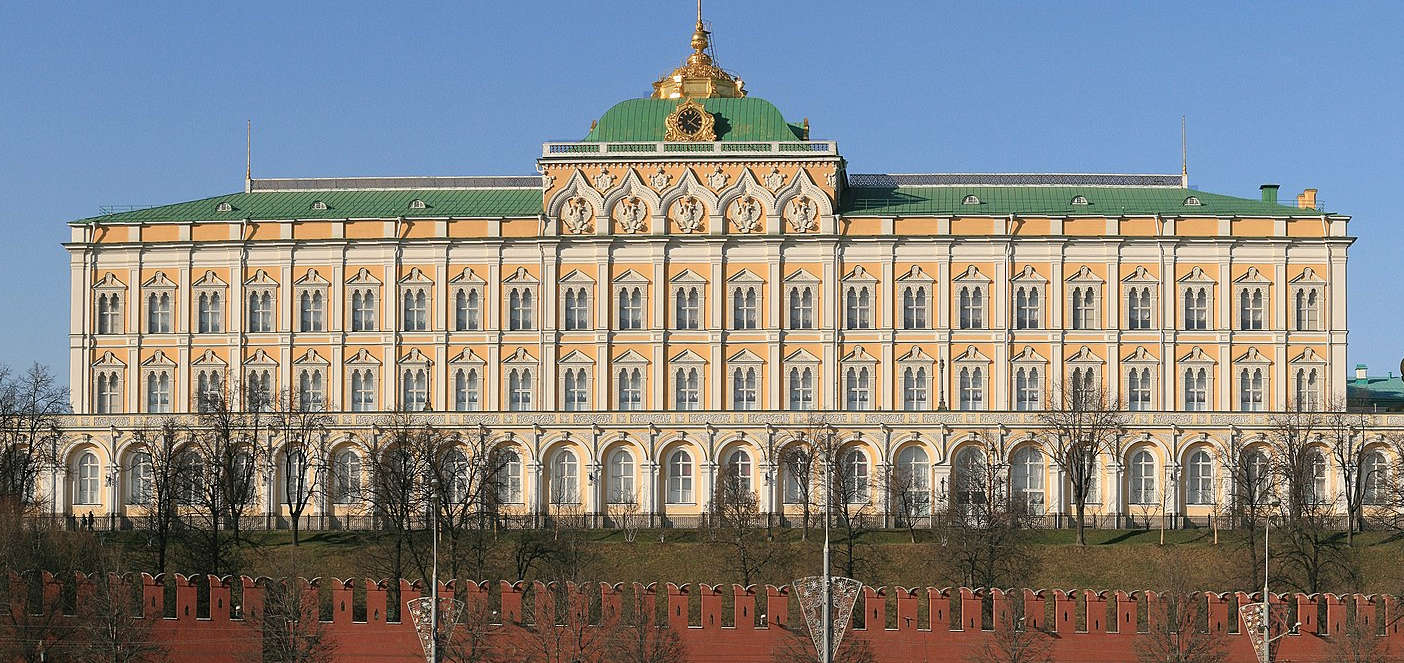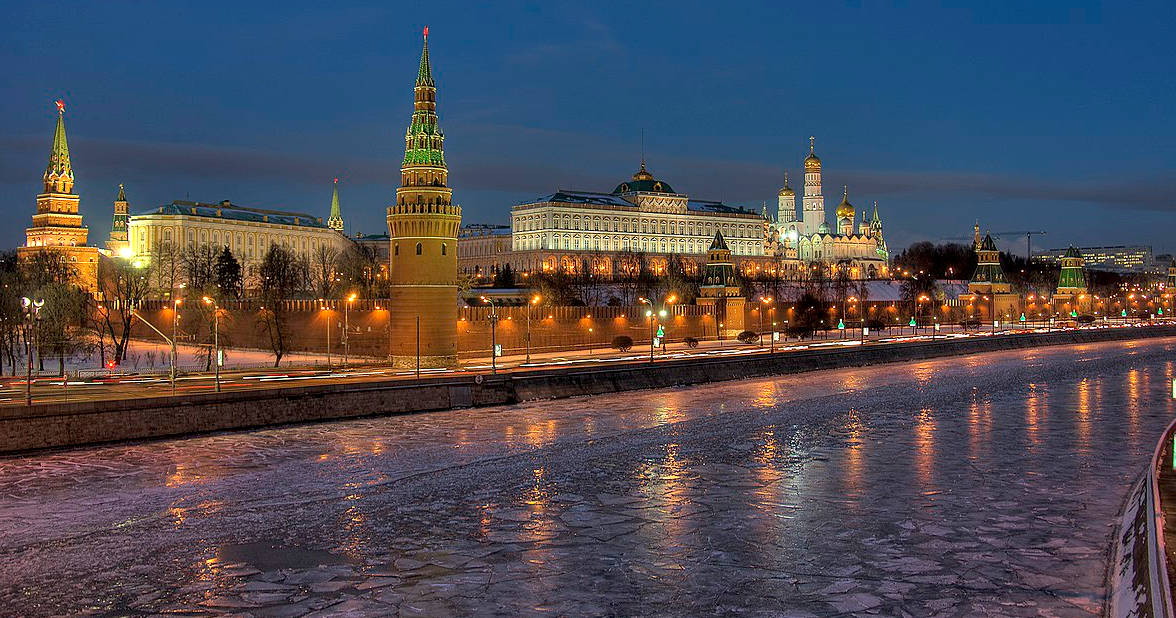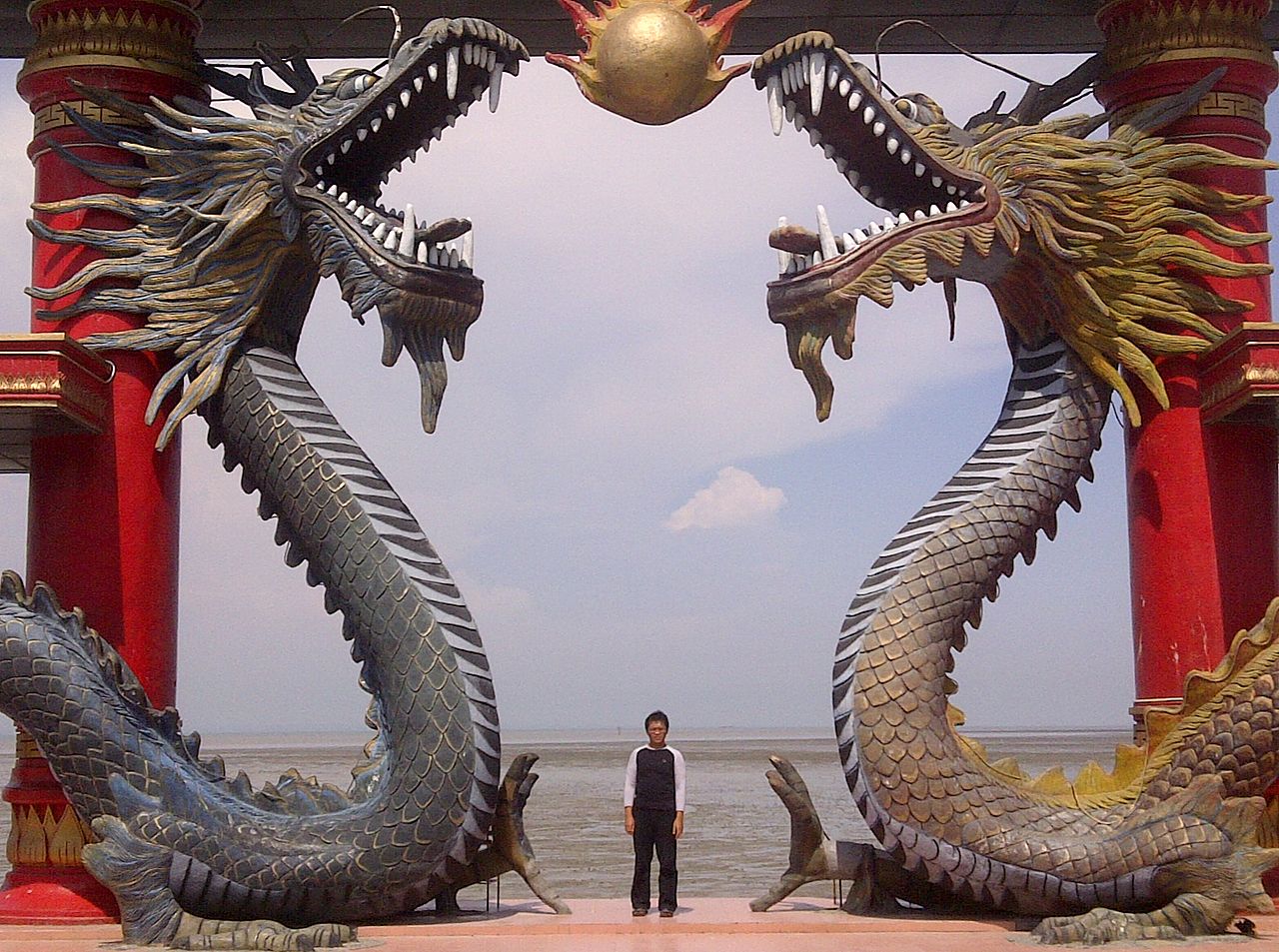|

Russian
presidential palace. The Kremlin, a building of legend.
The Moscow Kremlin (Russian: Московский Кремль), or simply the Kremlin, is a fortified complex in Moscow, Russia. Located in the centre of the country's capital city, it is the best known of the kremlins (Russian citadels) and includes five palaces, four cathedrals, and the enclosing Kremlin Wall along with the Kremlin towers. Within the complex is the Grand Kremlin Palace, which served as the royal residence of the Emperor of Russia. It is now the official residence of the President of the
Russian Federation. The Kremlin overlooks the Moskva River to the south, Saint Basil's Cathedral and Red Square to the east, and Alexander Garden to the west.
The name kremlin means "fortress inside a city" in Russian, and is often also used metonymically in international politics to refer to the Government of the Russian Federation. Likewise, during the
Cold
War, it referred to the Government of the Soviet Union, which operated out of the city in the erstwhile Russian SFSR. The term "Kremlinology" is related to the metonym and refers to the study of Soviet and Russian politics.
GOVERNMENT
The government of Russia is the federal executive body of state power of the Russian Federation. The members of the government are the prime minister, the deputy prime ministers, and the federal ministers. It has its legal basis in the Constitution of the Russian Federation and the federal constitutional law "On the Government of the Russian Federation". The Apparatus of the Government of Russia is a governmental body which administrates the activities of the government.
According to the 1991 amendment to the 1978 constitution, the President of Russia was the head of the executive branch and headed the Council of Ministers of Russia. According to the current 1993 constitution, the president is not a part of the government of Russia, which exercises executive power. However, the president appoints the prime minister.
SOVIET PERIOD
The Soviet government moved from Petrograd (present-day Saint Petersburg) to Moscow on 12 March 1918. Vladimir Lenin selected the Kremlin Senate as his residence. Joseph Stalin also had his personal rooms in the Kremlin. He was eager to remove all the "relics of the tsarist regime" from his headquarters. Golden eagles on the towers were replaced by shining Kremlin stars, while the wall near Lenin's Mausoleum was turned into the Kremlin Wall Necropolis.
The Chudov Monastery and Ascension Convent, with their 16th-century cathedrals, were demolished to make room for the military school. The Little Nicholas Palace and the old Saviour Cathedral were pulled down as well.
During the Second World
War, in order to confuse the German pilots, the towers were repainted with different colors and covered with wooden tents. Every roof was painted rusty brown so as to make them indistinguishable from typical roofs in the city. The grounds, paved with cobblestone, were covered up with sand. Tents painted to look like roofs were stretched over the gardens, and the facades of the buildings were also painted.
The residence of the Soviet government was closed to tourists until 1955. It was not until the Khrushchev Thaw that the Kremlin was reopened to foreign visitors. The Kremlin Museums were established in 1961, and the complex was among the first Soviet patrimonies inscribed on the World Heritage List in 1990.
Although the current director of the Kremlin Museums, Elena Gagarina (Yuri Gagarin's daughter), advocates a full-scale restoration of the destroyed cloisters, recent developments have been confined to expensive restoration of the original interiors of the Grand Kremlin Palace, which were altered during Stalin's rule.
Overall, during the Soviet rule (1917–1991), 28 out of 54 historic buildings in the Kremlin were destroyed (among them 17 out of 31 churches and cathedrals), most of them centuries-old.
HELIPAD
To stop disruptions to traffic caused by motorcades, and presumably
inspired by the USA's helipad at the White
House, Russian President Vladimir Putin authorized the construction of a helipad in the Kremlin. The helipad was completed in May 2013. The Russian President
now commutes back and forth to the Kremlin using a Mil Mi-8 helicopter. Careful consideration was taken in choosing the location of the helipad. The location chosen is said to be of no threat to the architecture of the Kremlin.

The
beautiful Moskva river and Kremlin Palace
MOSCOW
Moscow is the capital and largest city of Russia. The city stands on the Moskva River in Central Russia, with a population estimated at over 13 million residents within the city limits, over 18.8 million residents in the urban area, and over 21.5 million residents in its metropolitan area. The city covers an area of 2,511 square kilometers (970 sq mi), while the urban area covers 5,891 square kilometers (2,275 sq mi), and the metropolitan area covers over 26,000 square kilometers (10,000 sq mi). Moscow is among the world's largest cities, being the most populous city in its entirety in Europe, the largest urban and metropolitan area in Europe, and the largest city by land area on the European continent.
First documented in 1147, Moscow grew to serve as the capital of the Grand Duchy of Moscow. When the Tsardom of Russia was proclaimed, Moscow remained the political and economic center for most of its history. Under the reign of Peter the Great, the Russian capital was moved to the newly founded city of Saint Petersburg in 1712, decreasing Moscow's influence. Following the Russian Revolution and the establishment of the Russian SFSR, the capital was moved back to Moscow in 1918, where it later became the political center of the Soviet Union.[16] In the aftermath of the dissolution of the Soviet Union, Moscow remained the capital city of the newly established Russian Federation.
The northernmost and coldest megacity in the world, Moscow is governed as a federal city, where it serves as the political, economic, cultural, and scientific center of Russia and Eastern Europe. As an alpha world
city, Moscow has one of the world's largest urban economies. The city is one of the fastest-growing tourist destinations in the world and is one of Europe's most visited cities. Moscow is inhabited by the sixth-highest number of
billionaires of any city in the world. The Moscow International Business Center is one of the largest financial centers in Europe and the world and features the majority of Europe's tallest skyscrapers. Moscow was the host city of the 1980 Summer Olympics and one of the host cities of the 2018 FIFA World Cup.
Moscow is the home of multiple Russian artists, scientists, and sports figures, along with museums, academic and political institutions, and theaters. The city contains several
UNESCO
World Heritage Sites and is known for its display of Russian architecture, particularly in areas such as the Red Square and buildings such as the Saint Basil's Cathedral and the Moscow Kremlin, the latter of which is the seat of power of the Government of Russia. Moscow is home to Russian companies in different industries and is served by a comprehensive transit network, which includes four international airports, ten railway terminals, a tram system, a monorail system, and the Moscow Metro, which is the busiest metro system in Europe and one of the largest rapid transit systems in the world. The city has over 40 percent of its territory covered by greenery, making it one of the greenest cities in the world.
According
to the media, and it is alleged, that the move to a so-called democracy,
appears to have been to increase revenues for a state that is actually
controlled as though a communist state - especially during mock
elections. When if you don't vote the way they want, or if you attempt
to stand in opposition, you will disappear into their prison system or
not live that long. Elections are thus not free in the usual sense of
human rights freedoms. The political sham was/is quite a clever ruse on
the part of the Russians to lull the West into a false sense of
security. While actually, the country continued to stockpile nuclear
missiles aimed at America, from their new found oil and gas incomes,
while pretending to be an administrative sheep, but actually a military
wolf in sheep's clothing.
USSR TO RUSSIA 1991
When the USSR was dissolved in 1991, Moscow remained the capital of the Russian Federation. Since then, a market economy has emerged, producing an explosion of Western-style retailing, services, architecture, and lifestyles. The city continued to grow during the 1990s to 2000s, its population rising from below nine to above ten million. Mason and Nigmatullina argue that Soviet-era urban-growth controls produced controlled and sustainable metropolitan development, typified by the greenbelt built in 1935. Since then, however, there has been a dramatic growth of low-density suburban sprawl, created by heavy demand for single-family dwellings as opposed to crowded apartments. In 1995–97 the MKAD ring road was widened from the initial four to ten lanes.
In December 2002 Bulvar Dmitriya Donskogo became the first Moscow Metro station that opened beyond the limits of MKAD. The Third Ring Road, intermediate between the early 19th-century Garden Ring and the Soviet-era outer ring road, was completed in 2004. The greenbelt is becoming more and more fragmented, and satellite cities are appearing at the fringe. Summer dachas are being converted into year-round residences, and with the proliferation of automobiles there is heavy traffic
congestion. Multiple old churches and other examples of architectural heritage that had been demolished during the Stalin era have been restored, such as the Cathedral of Christ the Saviour. In 2010s Moscow's Administration has launched some long duration projects like the Moja Ulitsa (in English: My Street) urban redevelopment program or the Residency renovation one.
By its territorial expansion on July 1, 2012, southwest into the Moscow Oblast the area of the capital more than doubled, going from 1,091 to 2,511 square kilometers (421 to 970 sq mi), resulting in Moscow becoming the largest city on the European continent by area; it also gained an additional population of 233,000 people. The annexed territory was officially named Новая Москва (New Moscow).
WHAT
ARE THE CRINKs?
The CRINKs axis refers to a group of autocratic countries that are increasingly working together in the background of conflicts in Ukraine and the Middle East. The term “CRINKs” stands for China, Russia, Iran, and North
Korea. Let’s break down each member of this axis:
China: As a rising global superpower, China has been assertive in its foreign policy. It seeks to expand its influence economically, militarily, and politically. Its Belt and Road Initiative (BRI) aims to connect Asia, Europe, and
Africa through infrastructure projects, but it has raised concerns about debt dependency and geopolitical
leverage, fostered by Xi
Jinping.
Russia:
Russia, under President
Vladimir Putin, has been assertive in its actions, including the annexation of Crimea, military intervention in Syria, and
cyber
warfare. It seeks to challenge Western dominance and maintain its sphere of influence in Eastern Europe and Central Asia.
Iran:
Iran,
under Ali
Khamanei is a regional power in the Middle
East. It has been involved in proxy conflicts in Syria, Yemen, and Iraq. Its nuclear program and support for militant groups have strained relations with the West. Iran seeks to assert its influence in the region and challenge Western interests.
North Korea: North Korea, led by
Kim Jong-un, is known for its nuclear weapons program and provocative actions. It poses a threat to regional stability and has strained relations with the West.
North Korea seeks to maintain its regime survival and leverage its nuclear capabilities.
HOW ARE CHINA, RUSSIA AND IRAN WORKING TOGETHER?
The four provide weaponry and oil for each other to "evade sanctions imposed by the West", said the i news site. Experts warn they are working "more closely together" in the background of conflicts in Ukraine, the Middle East and Africa.
Iran has been playing an "important role" in Russia's war, said Eliot A. Cohen in The Atlantic. Iranian drones "fly every night at Ukrainian cities", to reveal air defences and "pave the way" for Russian missiles.
In return, Russia reinforced Iran's defences against Israeli strikes with Russian weapons, said Taylor. This is part of a "strategic alliance" forged by Russia's invasion: a "mutually beneficial relationship" between two pariah states.
China, the most significant Crink nation, has also provided "a trade lifeline for Russia" since its invasion sparked western sanctions.
This week President Xi Jinping will welcome Vladimir Putin in China for the Russian president's second high-profile visit in less than a year, "the latest sign of their growing alignment", said CNN.
China also maintains close ties with Iran, providing it with support that has similarly diminished the impact of sanctions. The deepening relationship is driven by "mutual interests", said The Diplomat: China's "insatiable energy needs and Iran's quest for economic and diplomatic support". But it is underpinned by "a shared narrative of resistance against perceived Western hegemony".
At the heart of this geopolitical maelstrom lies China's "increasingly assertive global posture". Its deepening relationship with Iran and Russia can be understood through the lens of its "burgeoning superpower rivalry" with the US.
WHAT IS NORTH KOREA'S ROLE?
North Korea, perhaps the most unpredictable of the Crink nations, is taking advantage of the fragmenting international order to ramp up pressure on the US and South Korea.
Alongside its military development over the past few years, North Korea has been "chumming up to Russia and remaining on the right side of China", said The Times's Asia editor Richard Lloyd Parry.
Since Russia invaded Ukraine, the relationship between Pyongyang and Moscow has flourished. North Korea has provided Russia with much-needed ammunition and war materials in exchange for the "advanced technology" that Pyongyang covets, said Taylor.
North Korea's leader Kim Jong Un visited Russia last autumn, his first foreign trip since 2019, and pledged closer military cooperation with Putin.
North Korean weapons were also used by Hamas in the 7 October attacks on Israel, according to the Israeli and South Korean military. North Korea denies this, but has sold anti-tank rocket launchers to Hamas in the past.
WHAT IS THE CRINK END GOAL?
The target of the Crink coalition is not the overthrow of a "rules-based international order", said Cohen, but rather of the "American-led world order" of the past 75 years. To achieve their goals, the major Crink players are "increasingly willing to use open violence" and to threaten the use of nuclear weapons.
Crucially, three out of four Crink nations are nuclear-armed, and Iran is "not far off", said Taylor.
Ultimately, said Cohen, "they are united by a growing belief that their moment is coming, when a divided and indecisive West, richer but flabbier, will not fight".
https://theweek.com/politics/crink-the-new-autocractic-axis-of-evil
https://theweek.com/politics/crink-the-new-autocractic-axis-of-evil

CHAPTERS
| CHARACTERS
| MEDIA
|
MOVIE REF |
SCREENPLAYS
|


